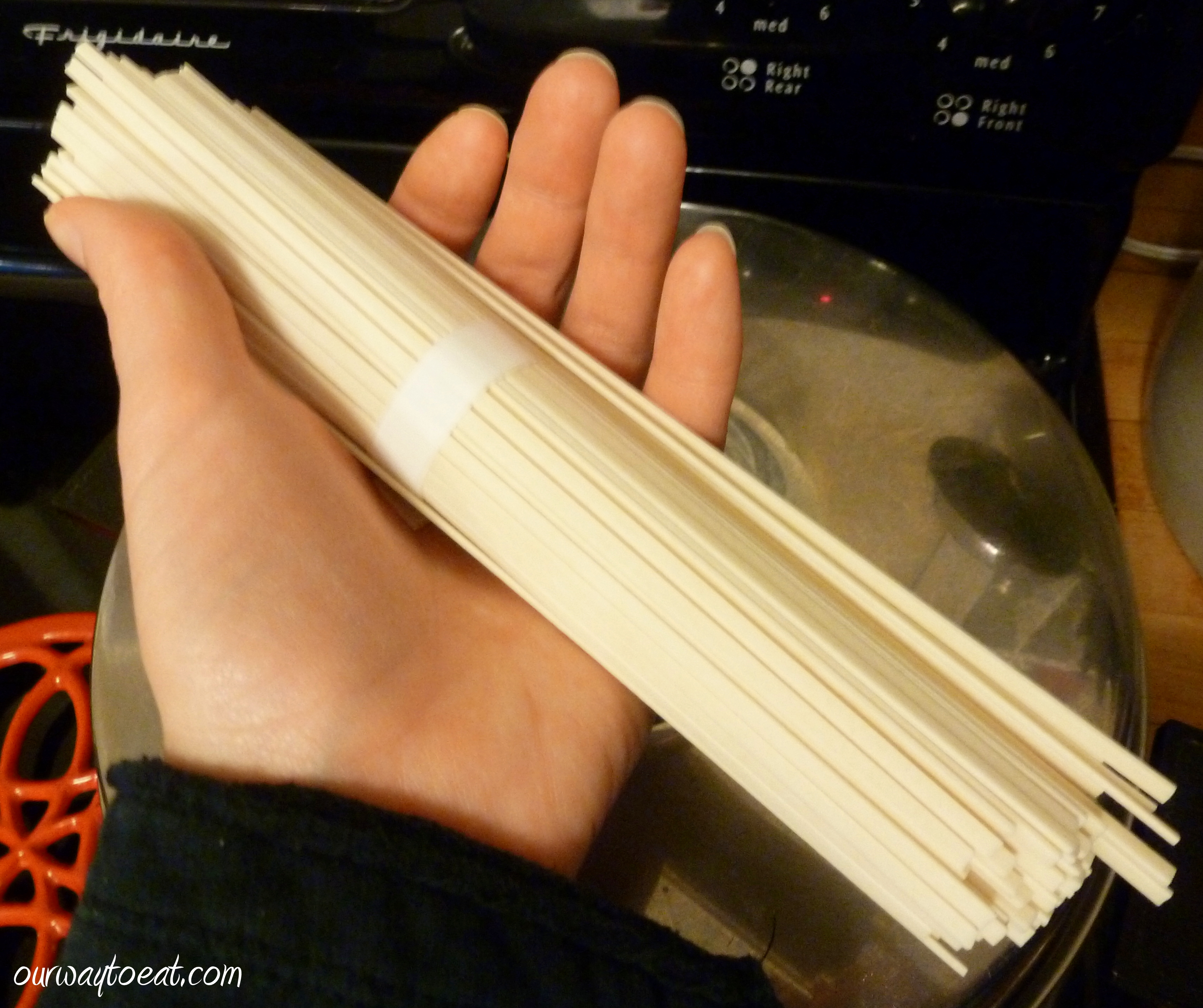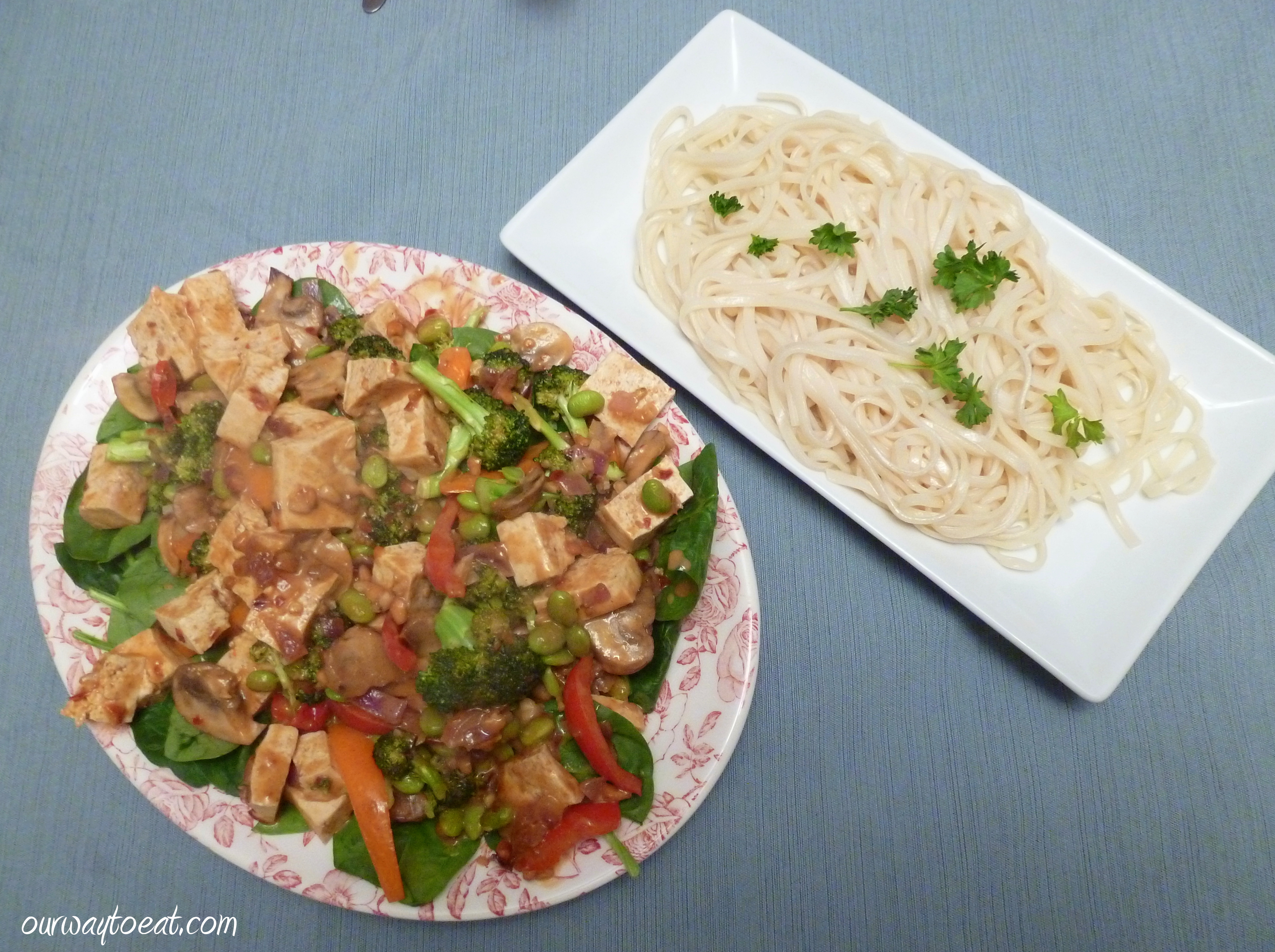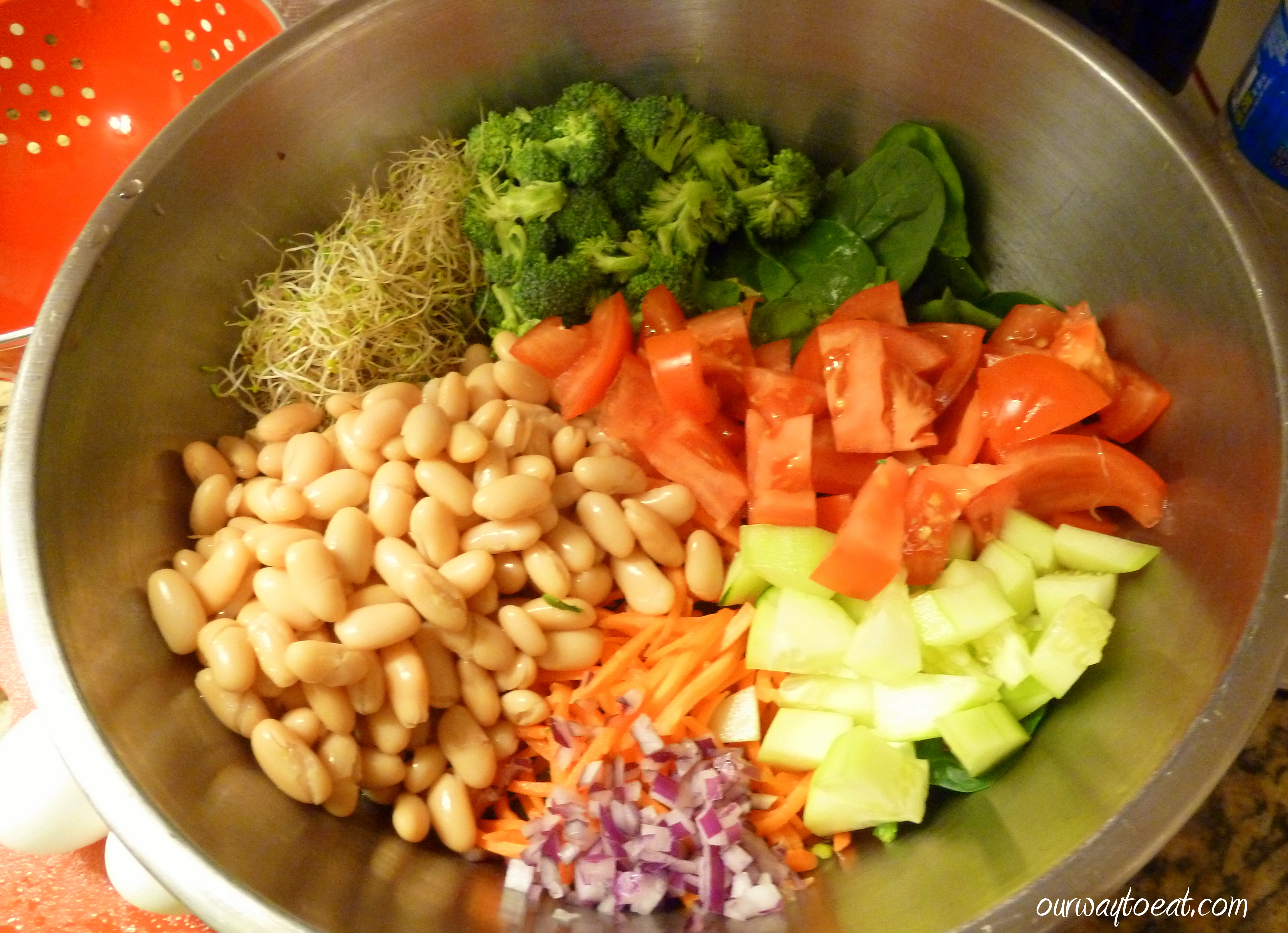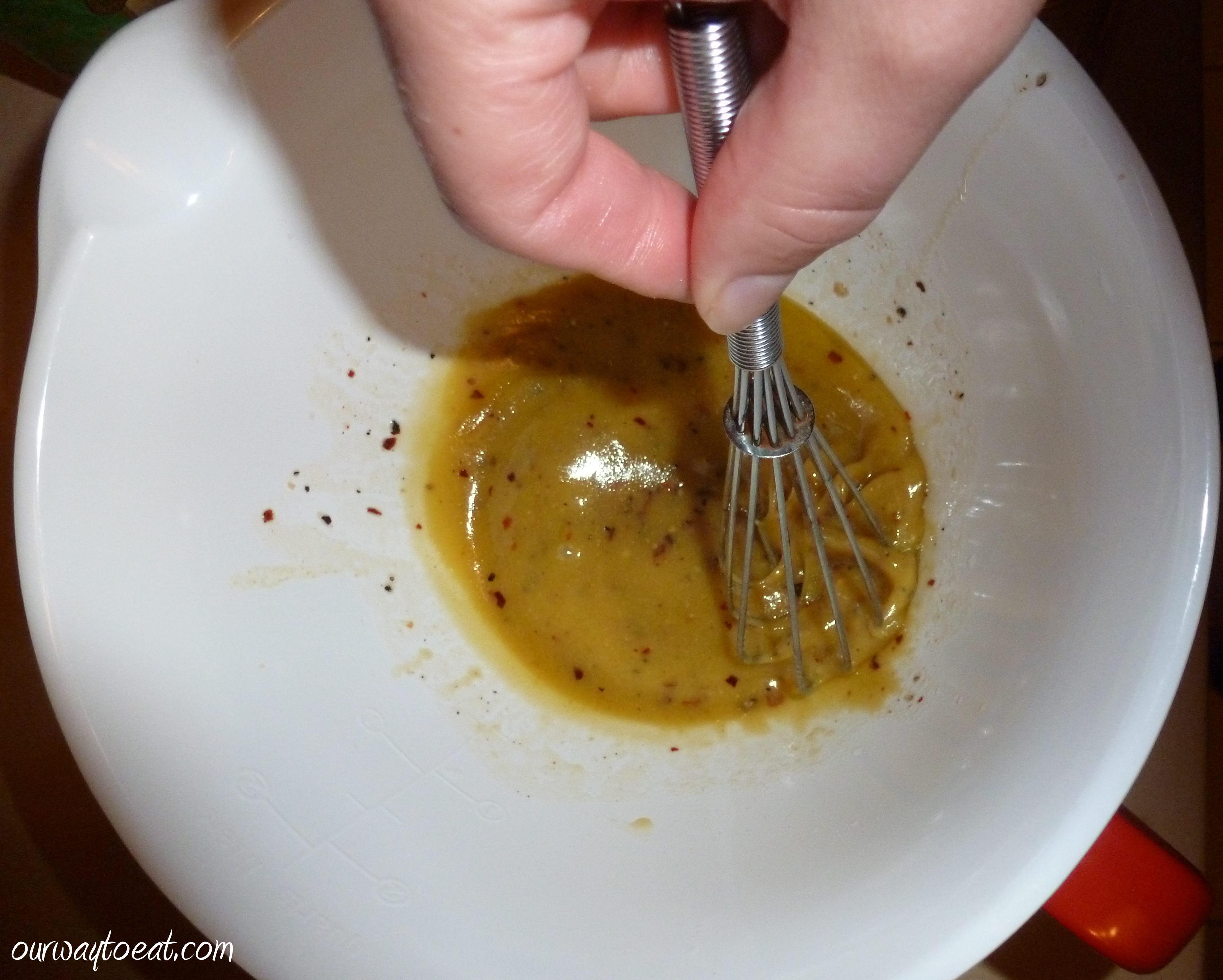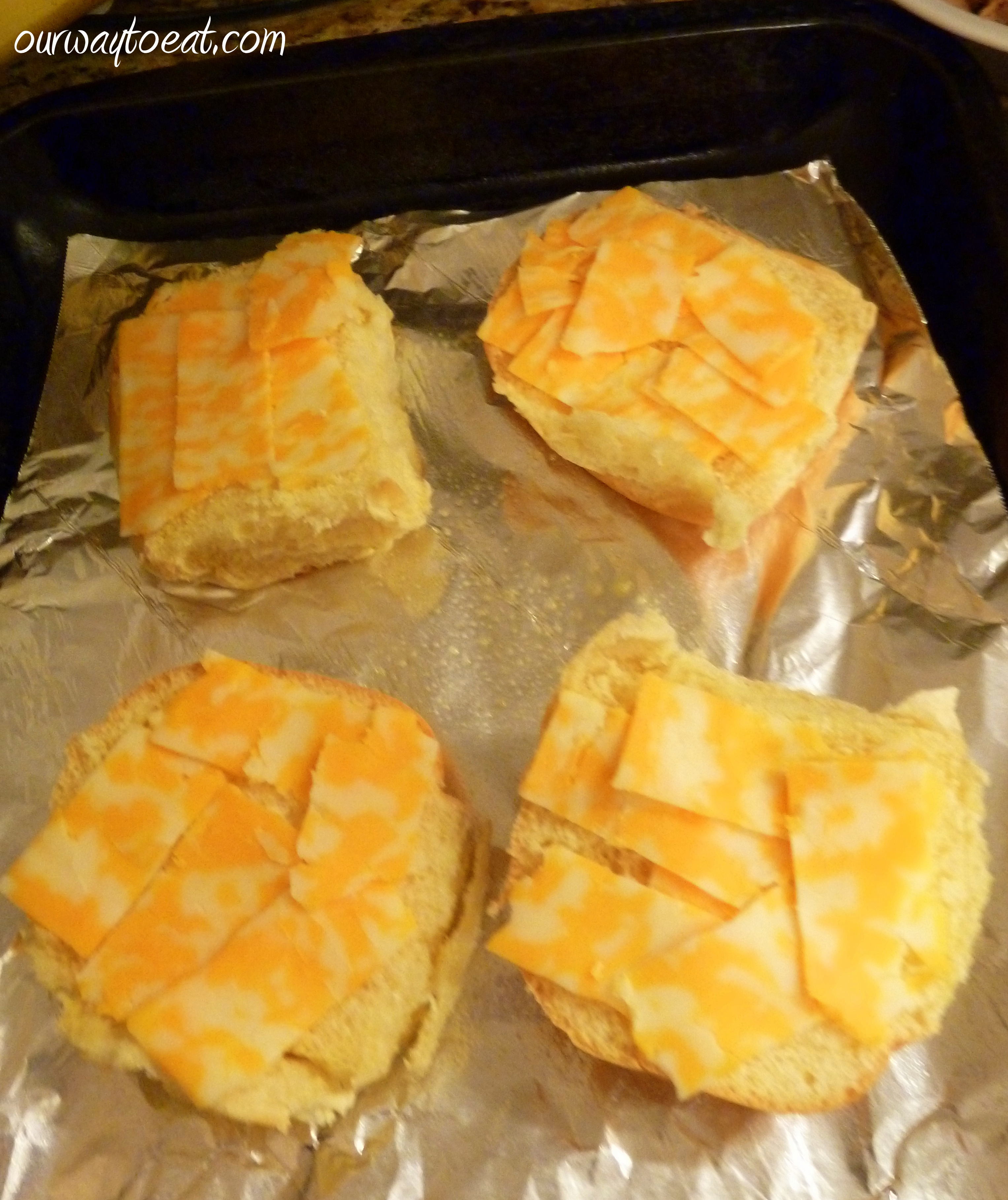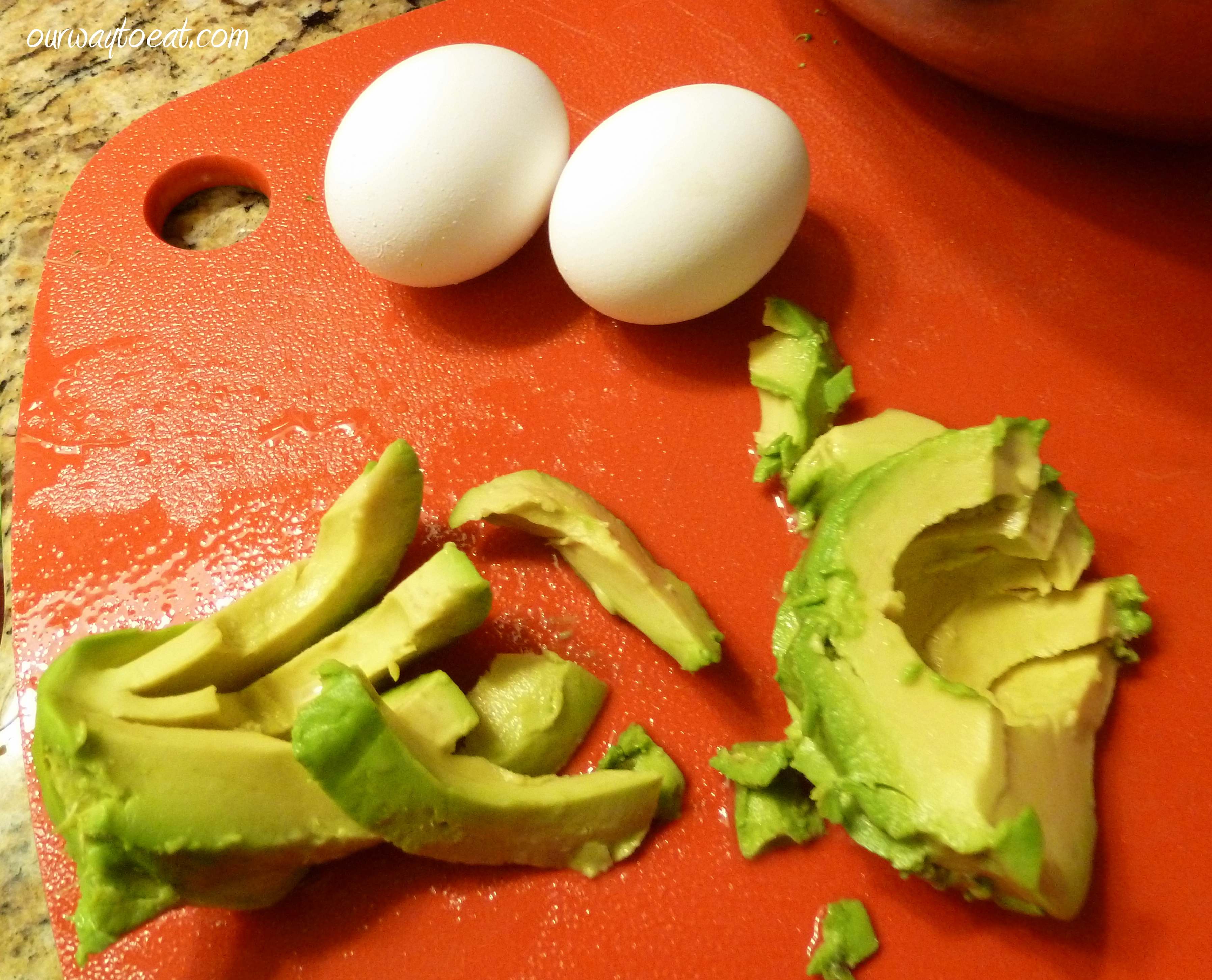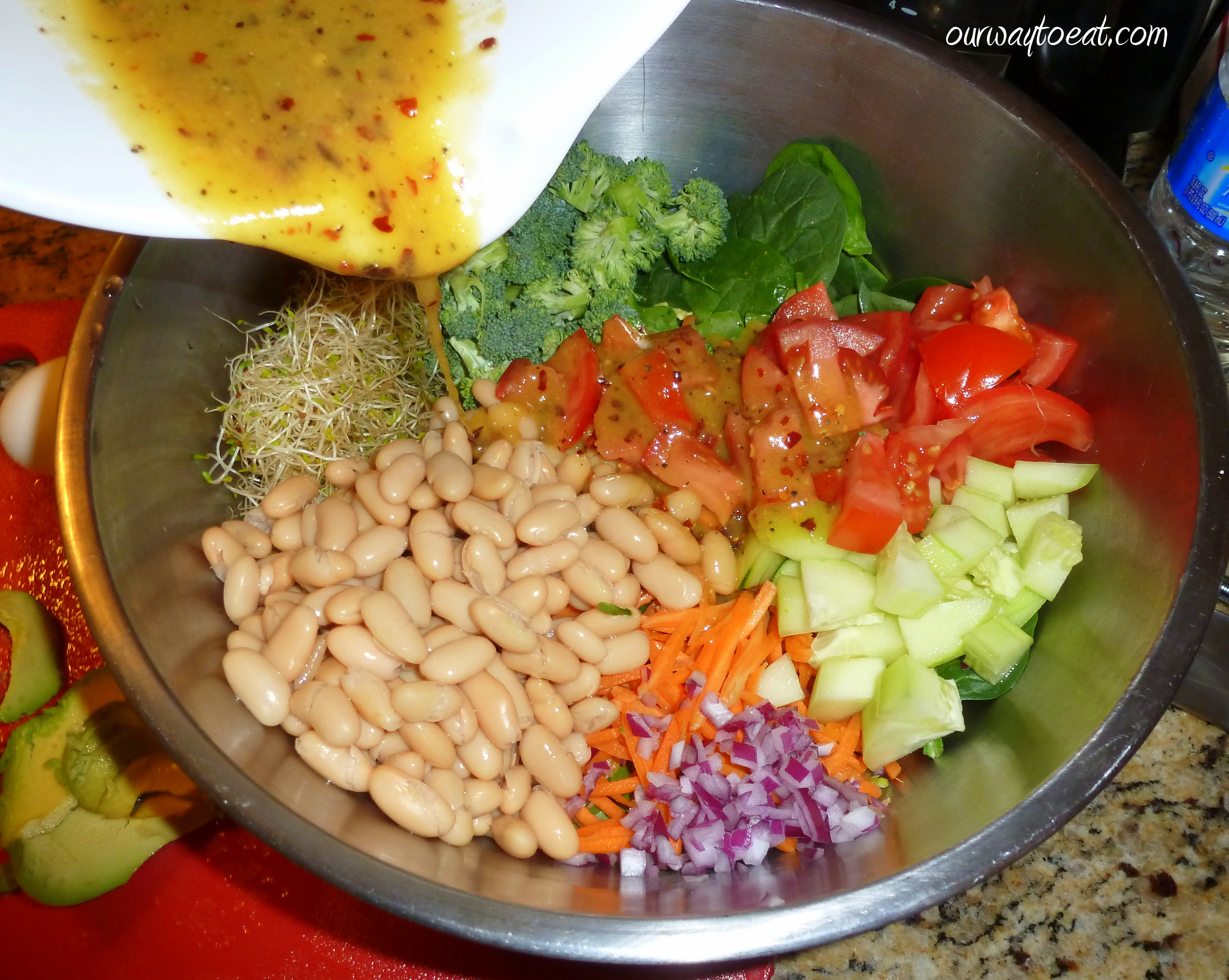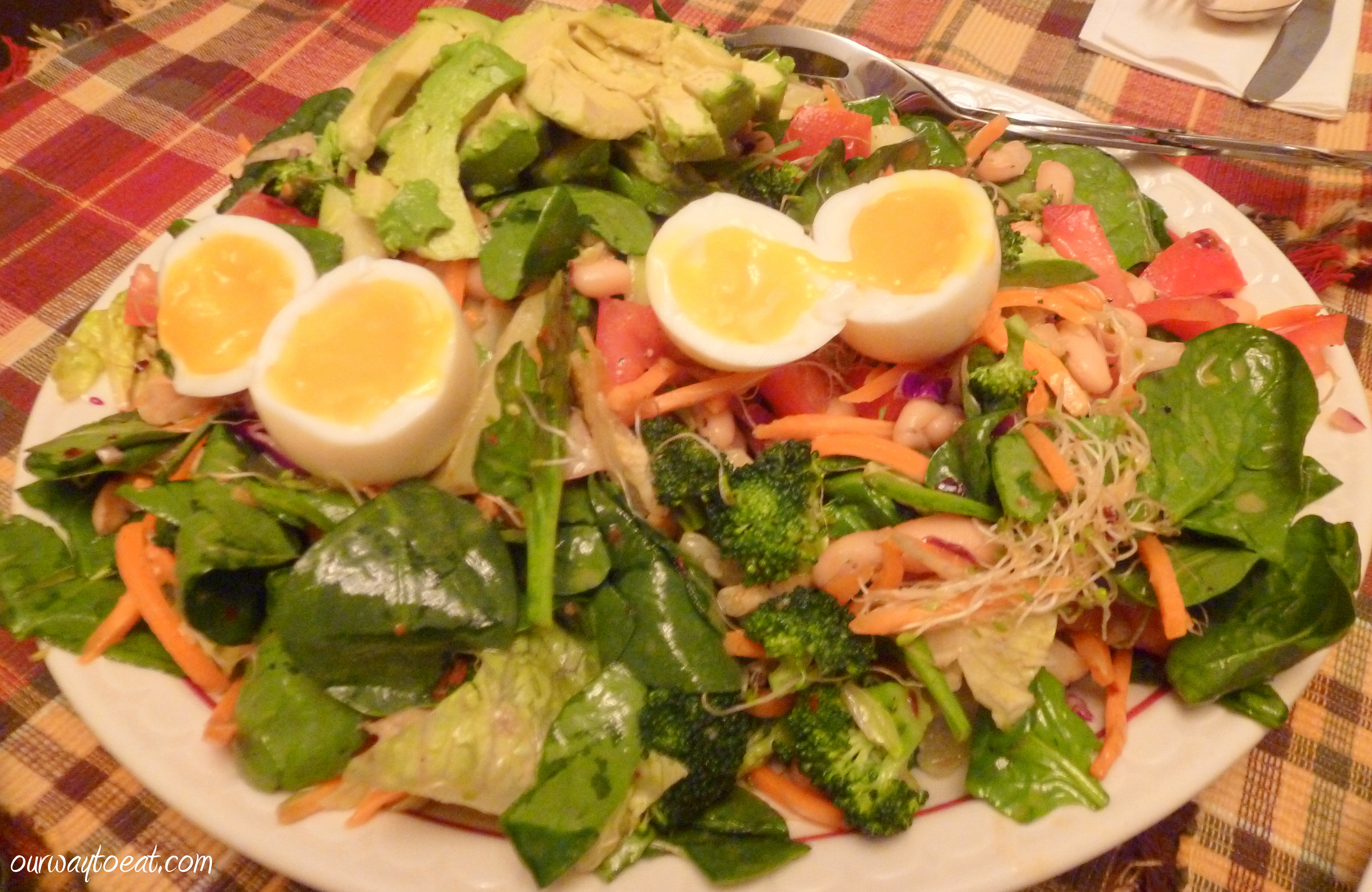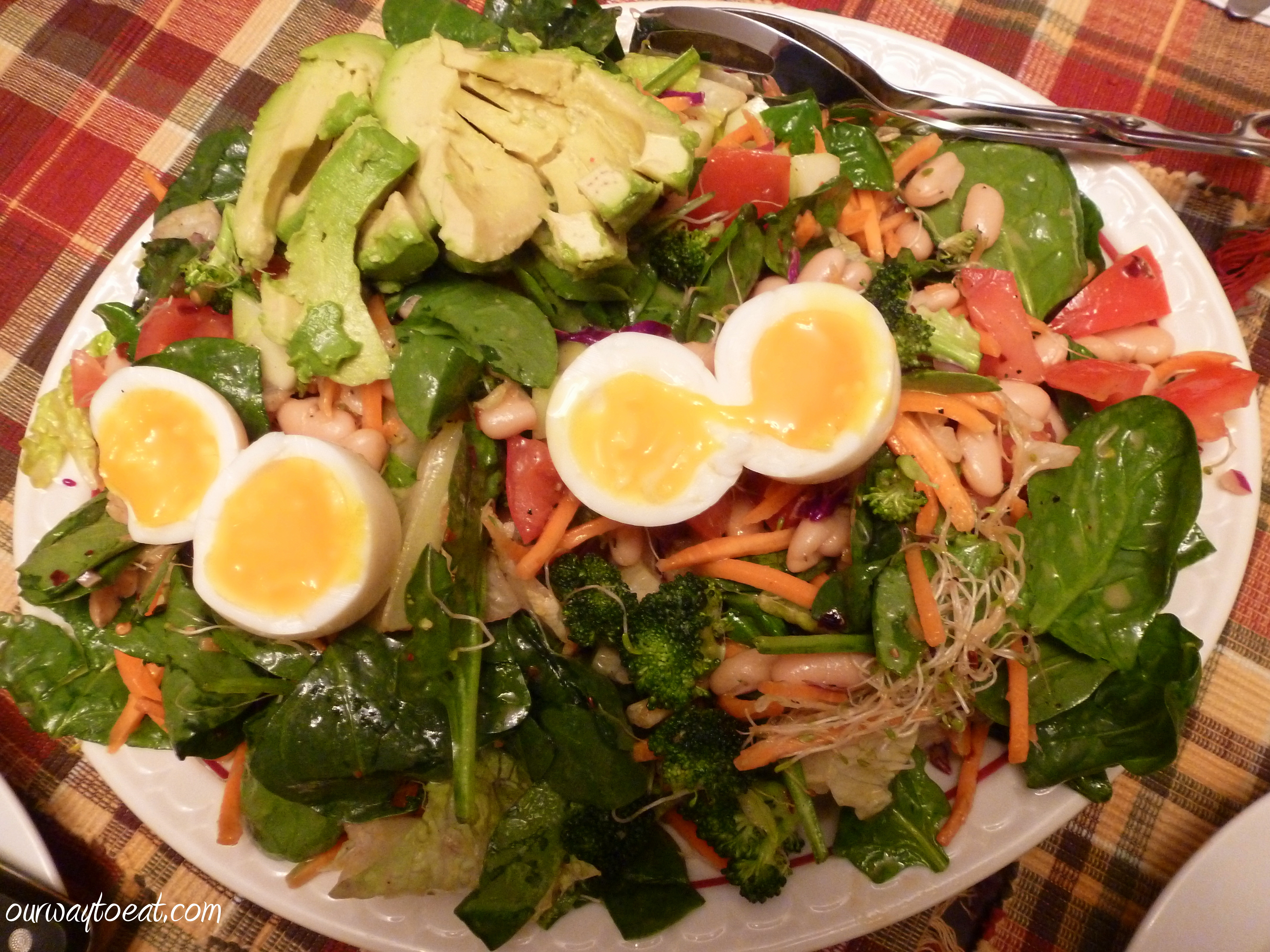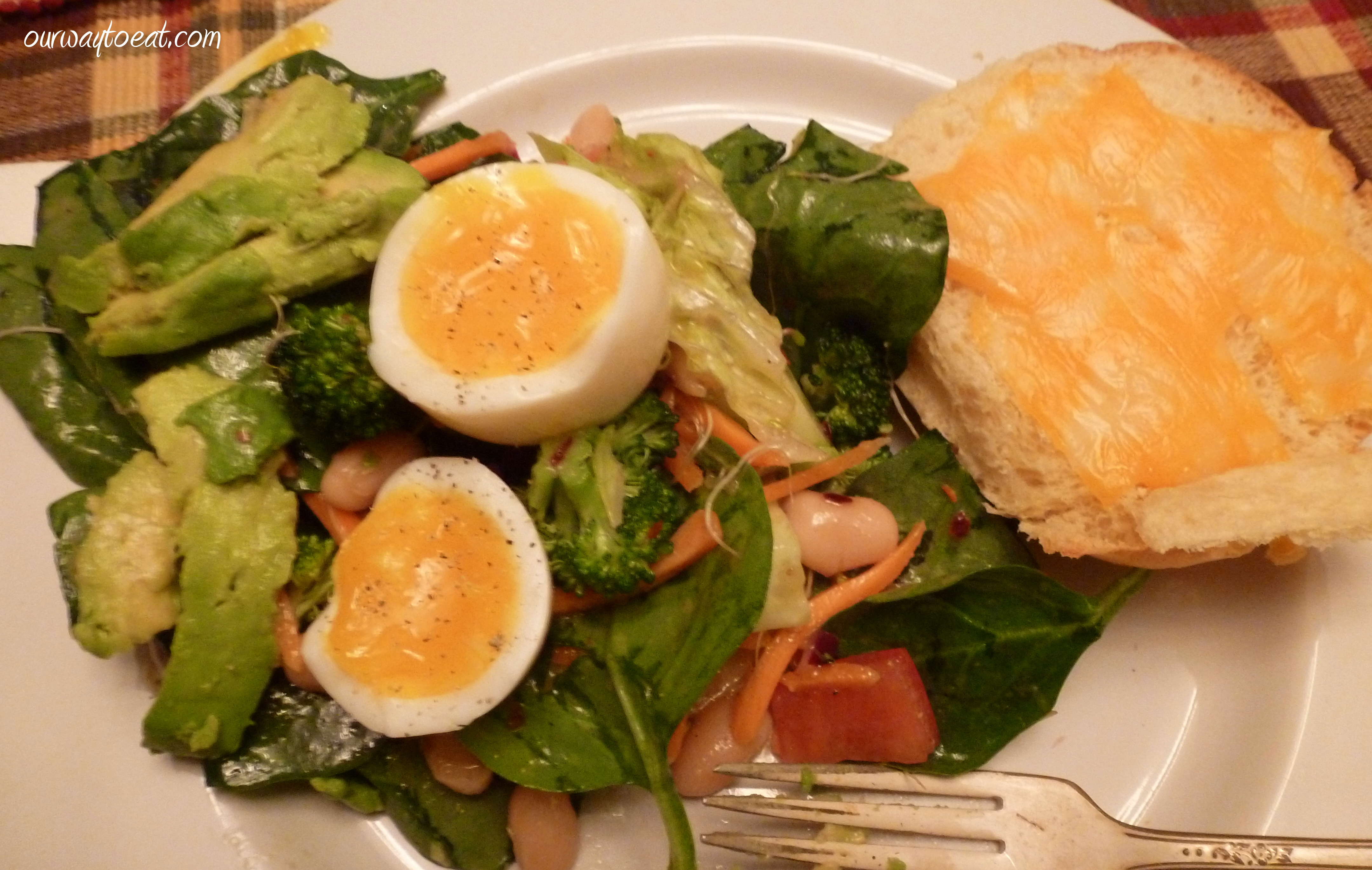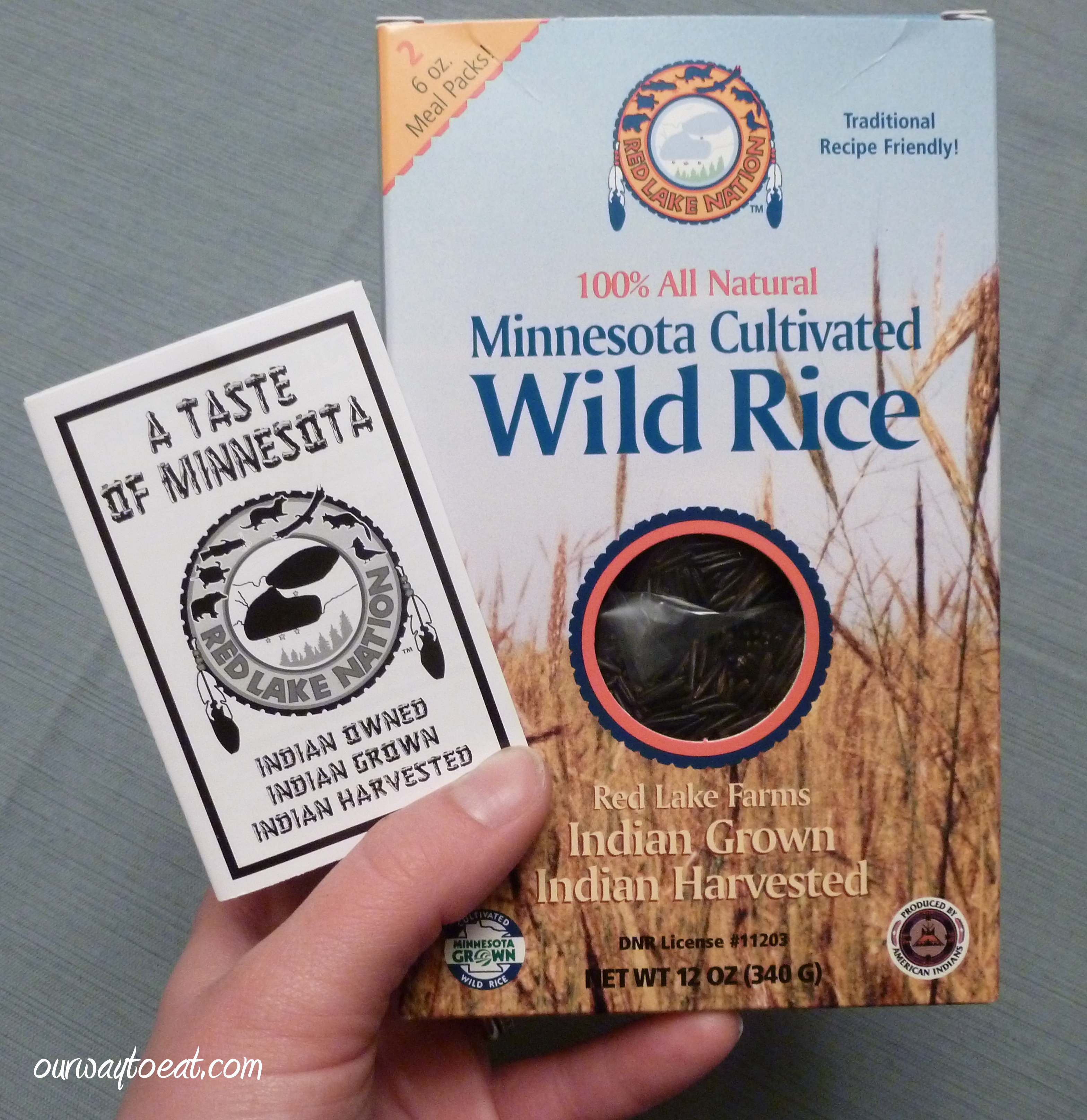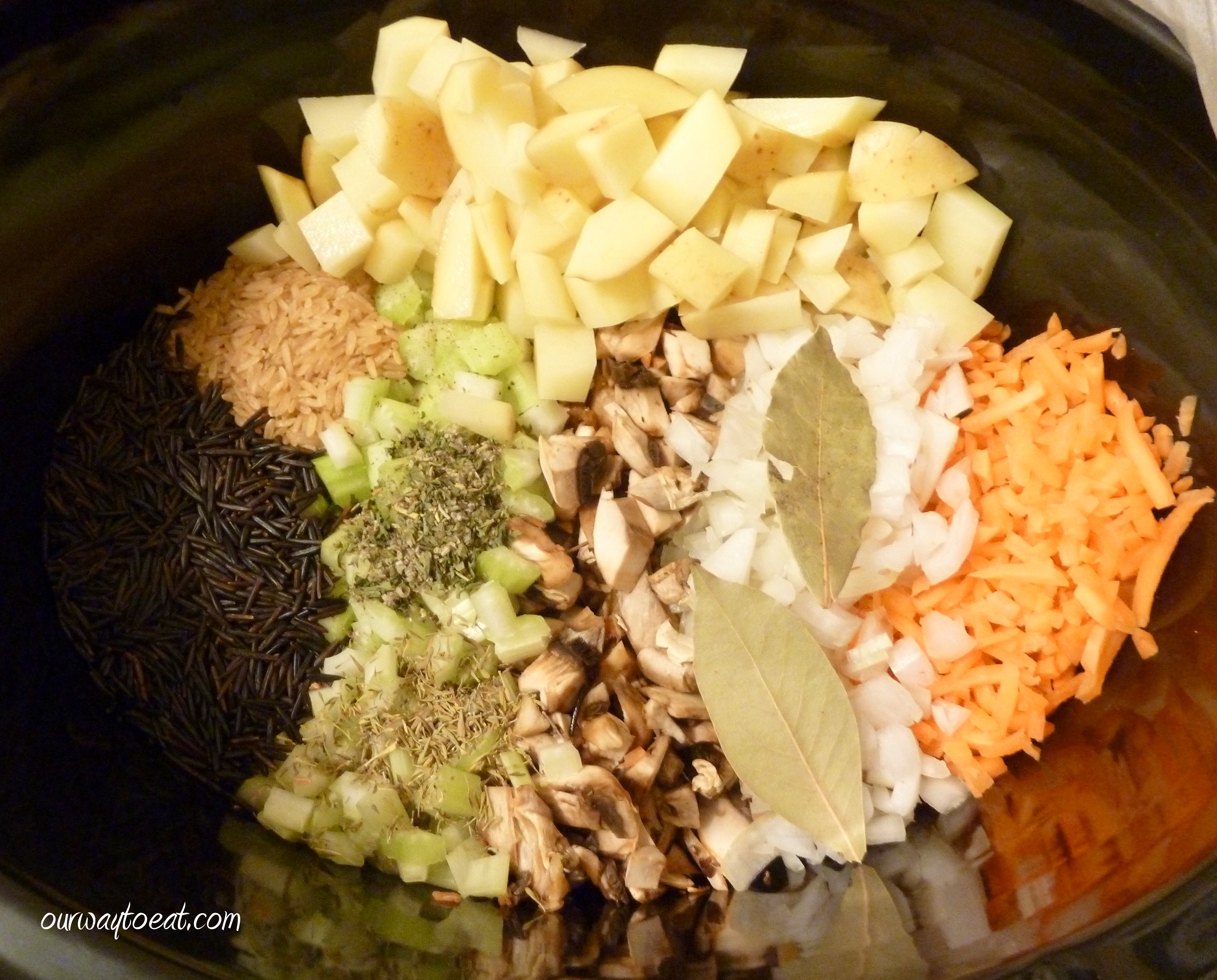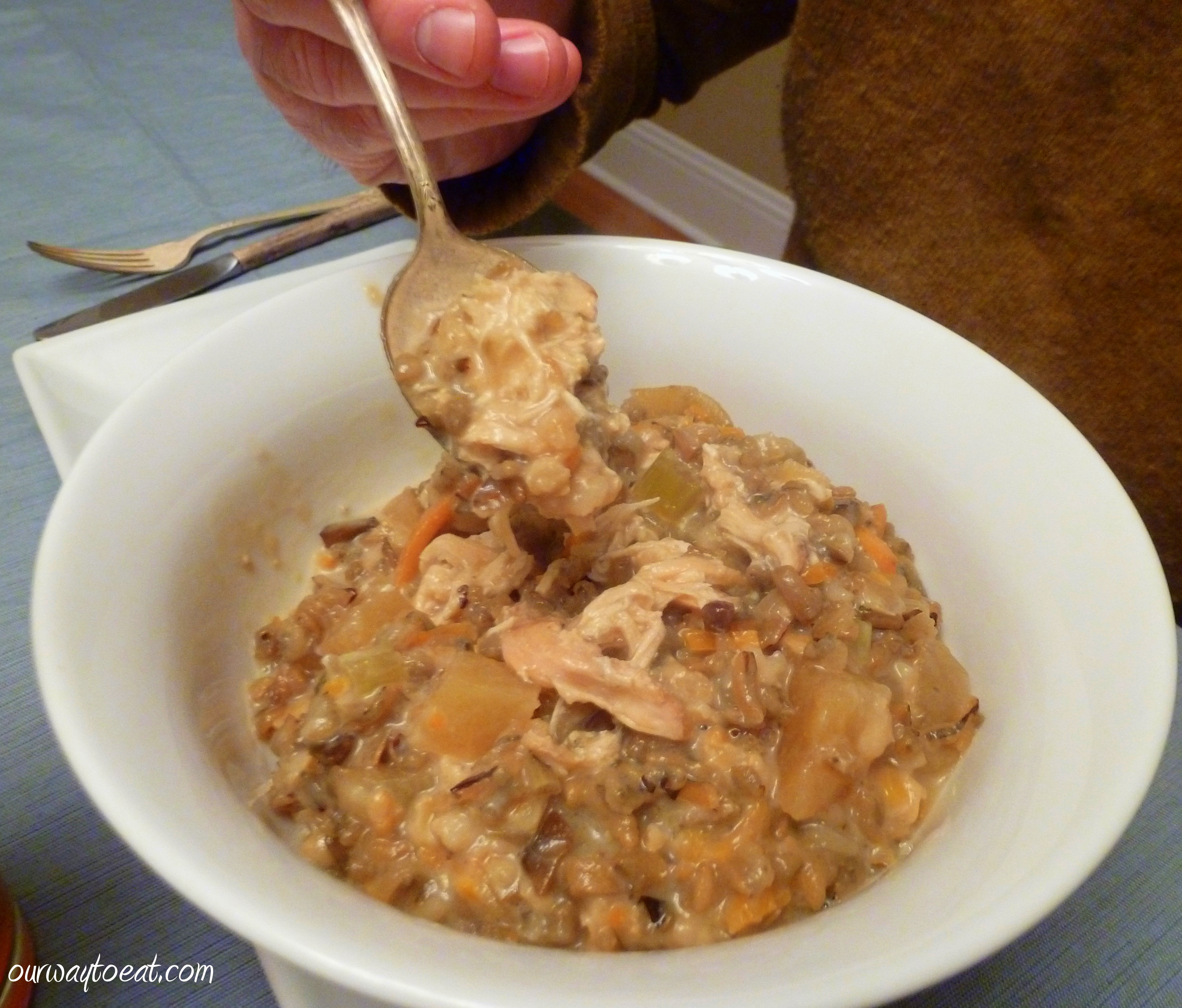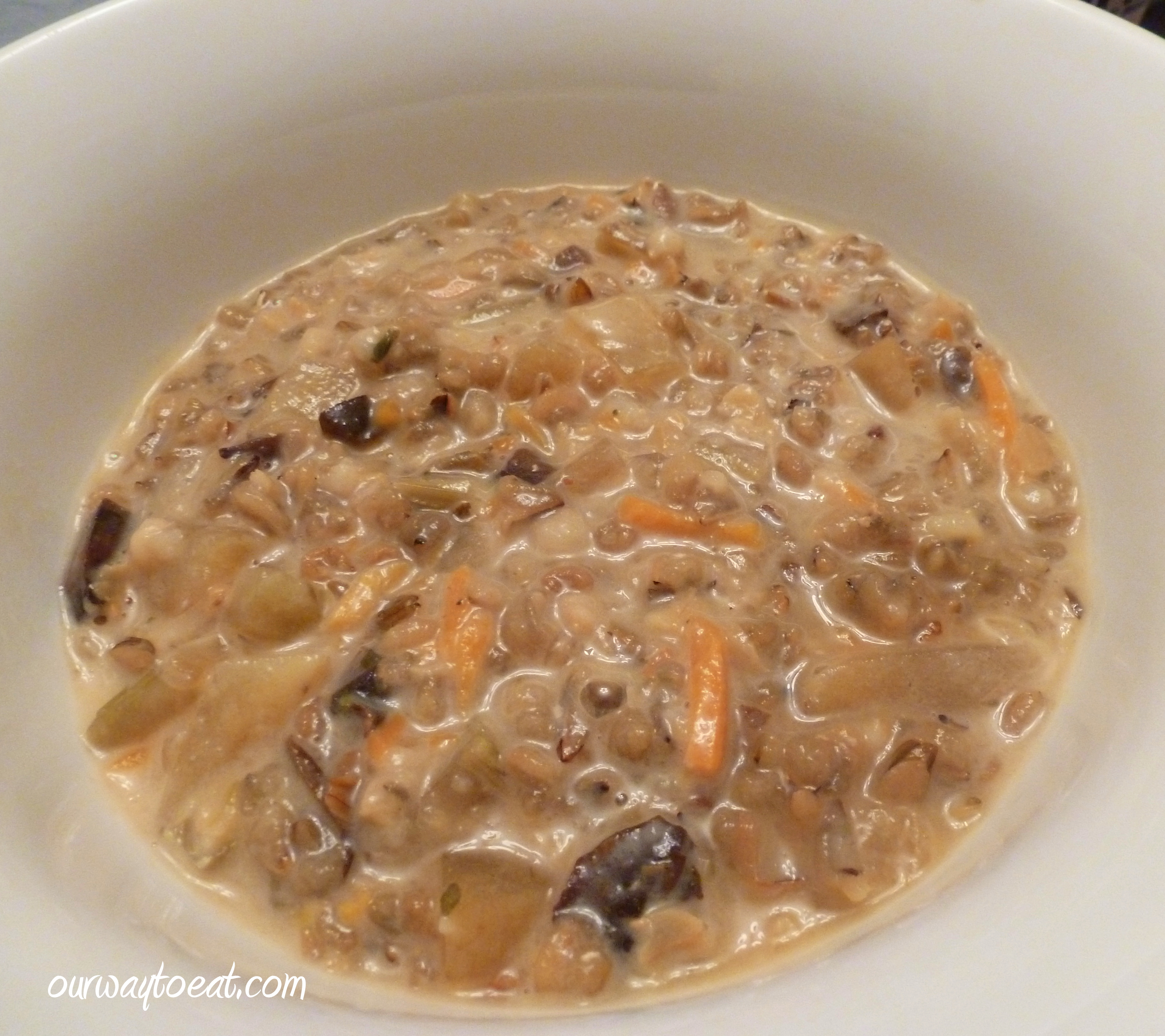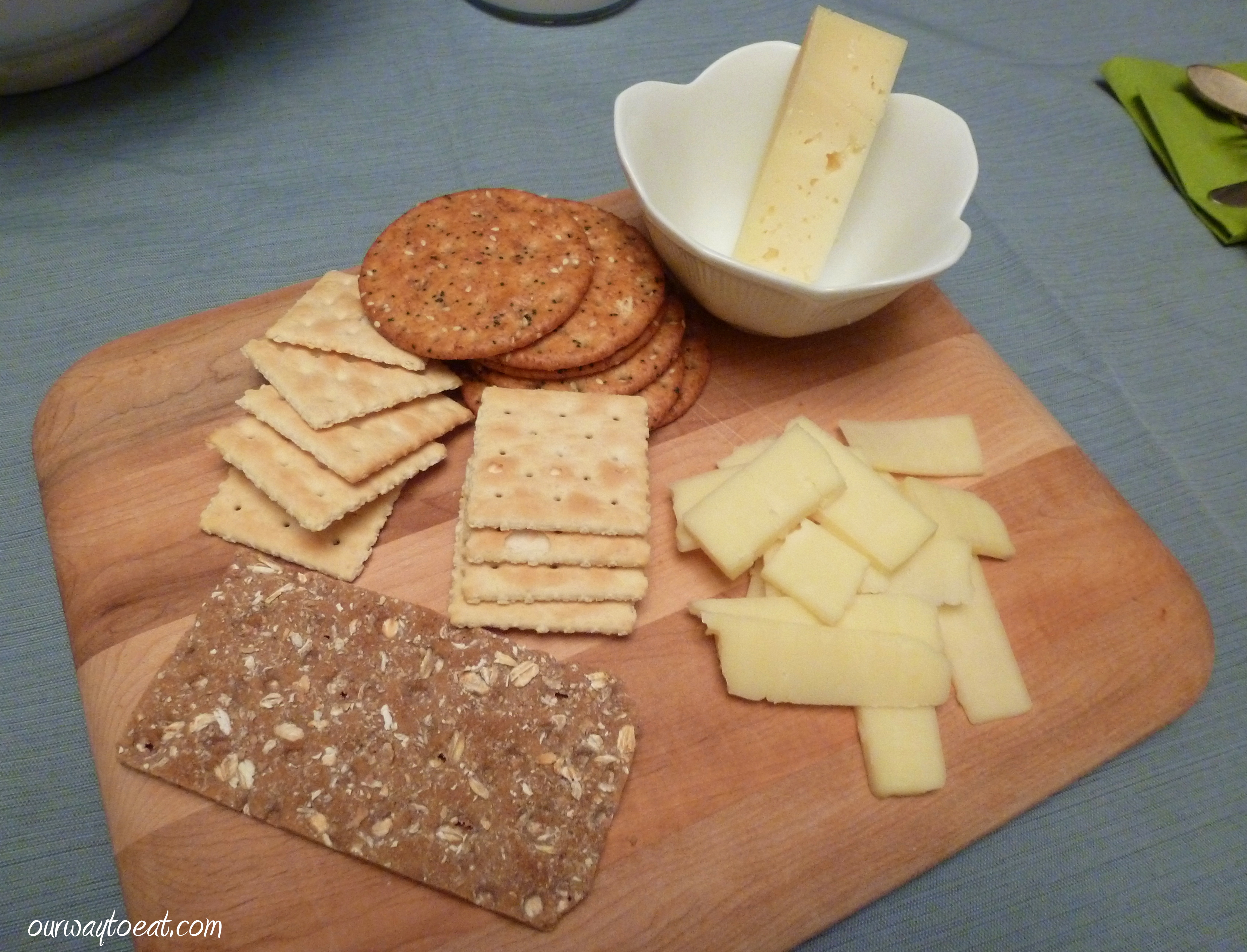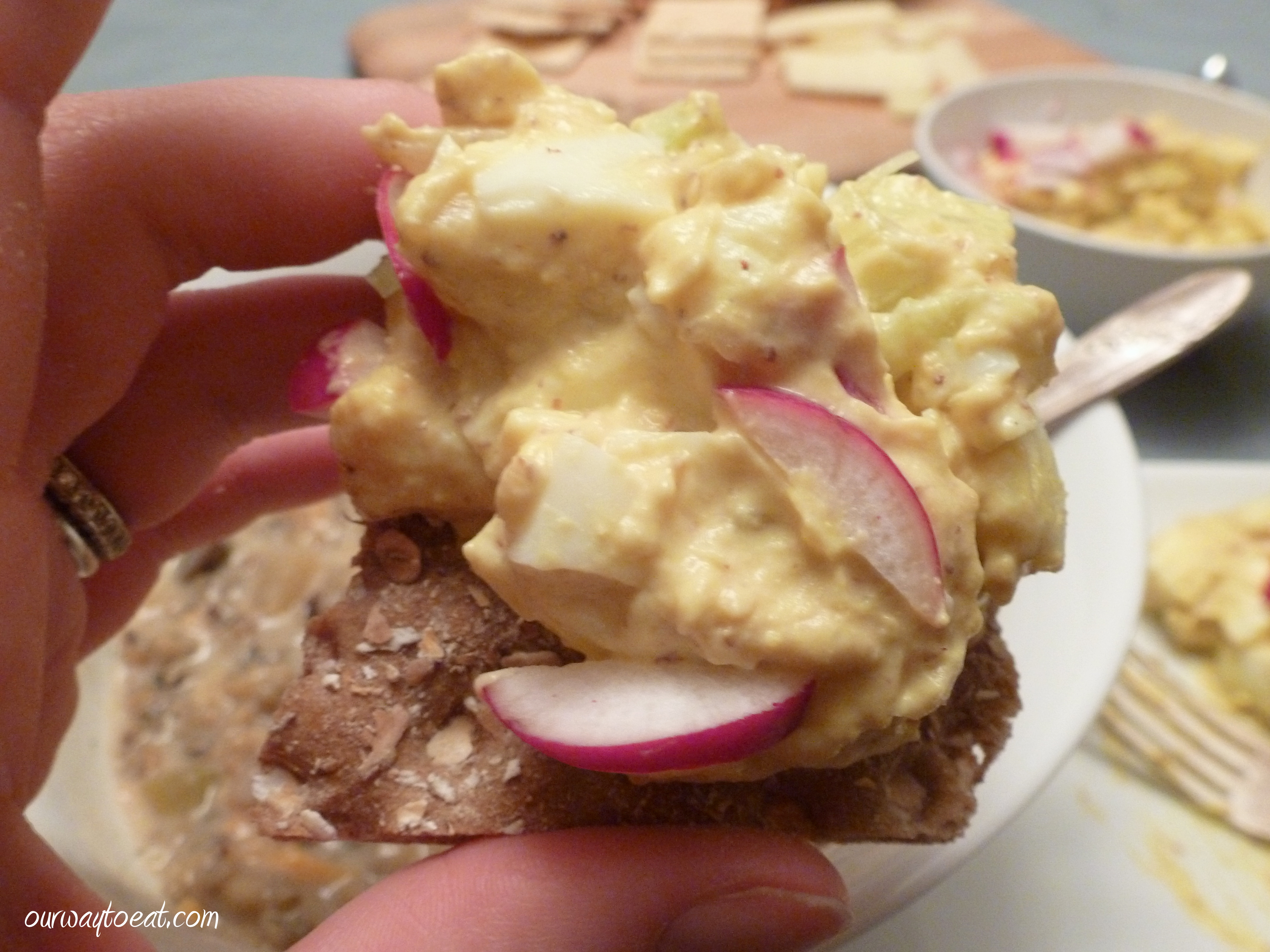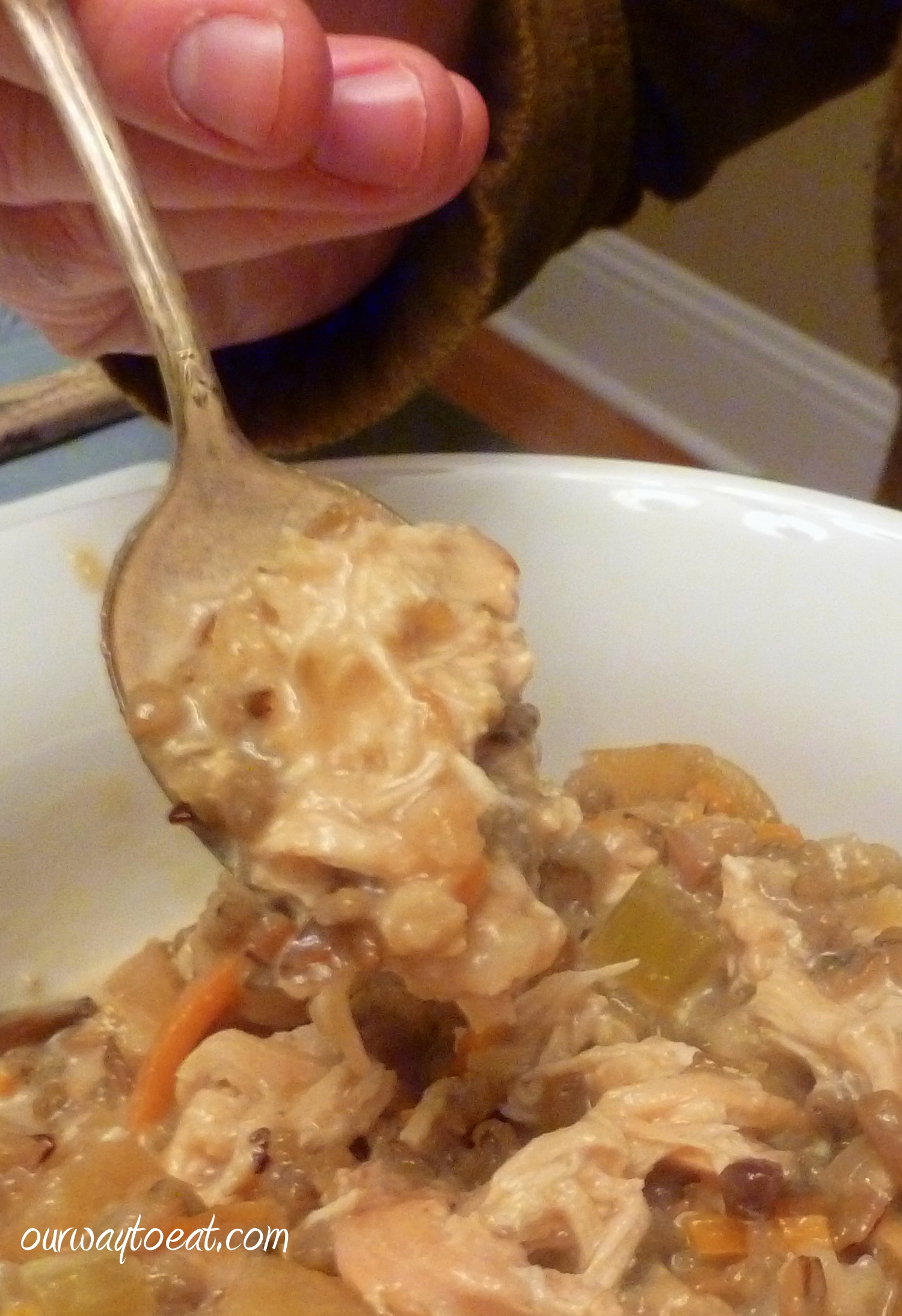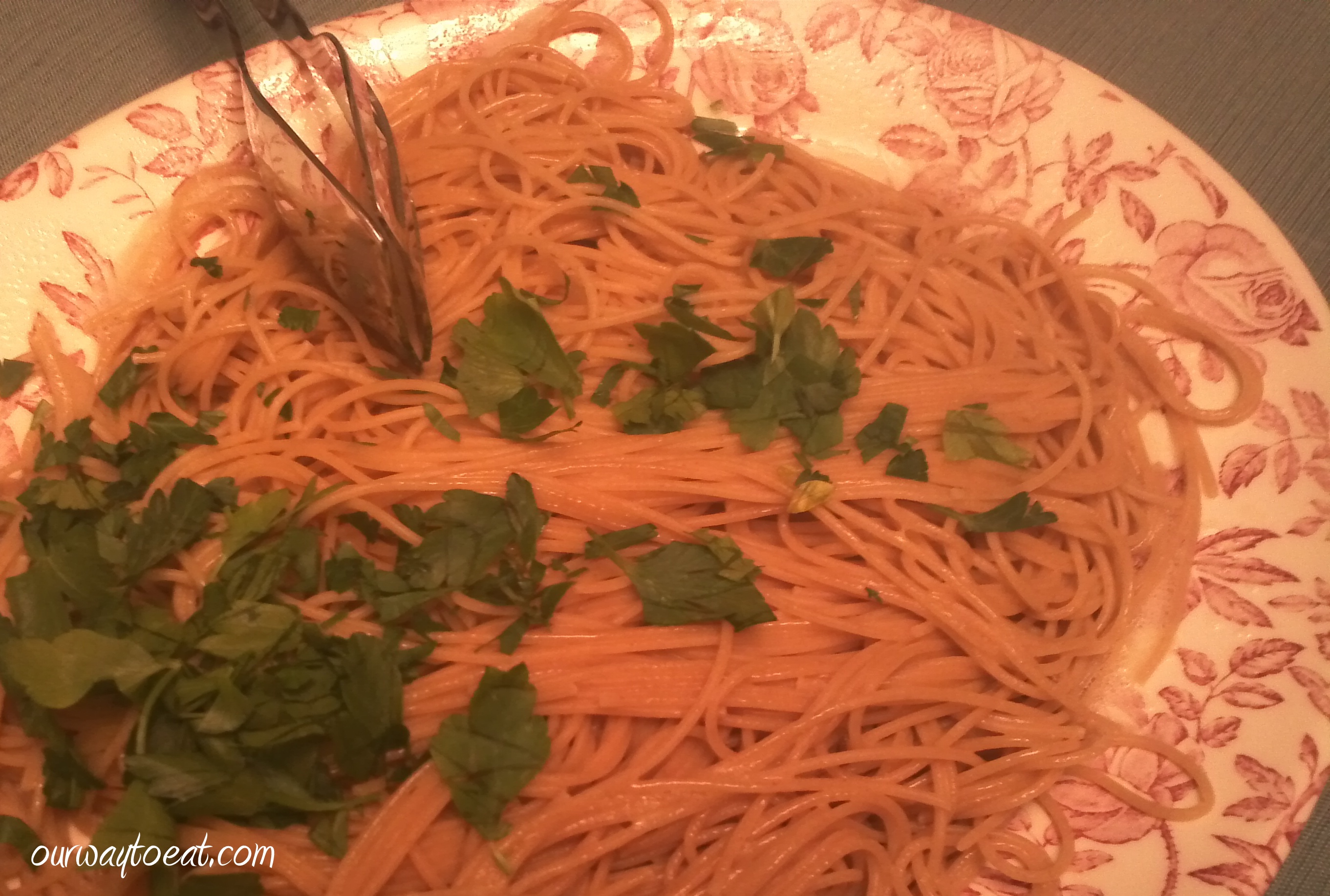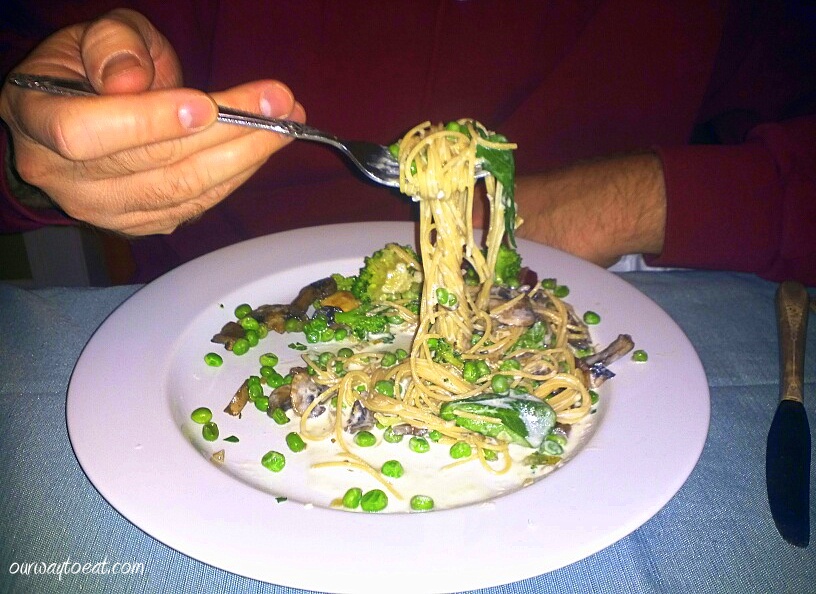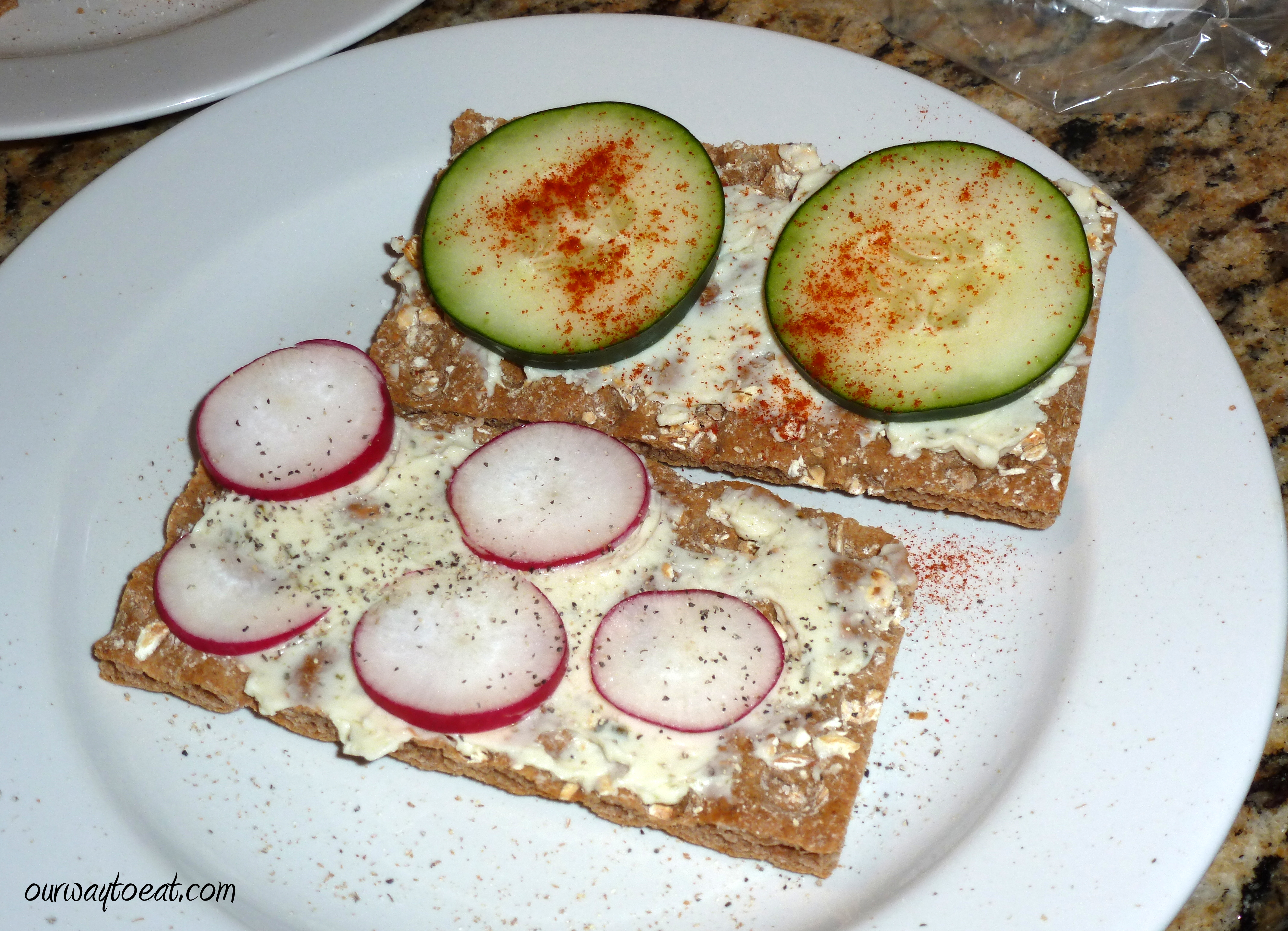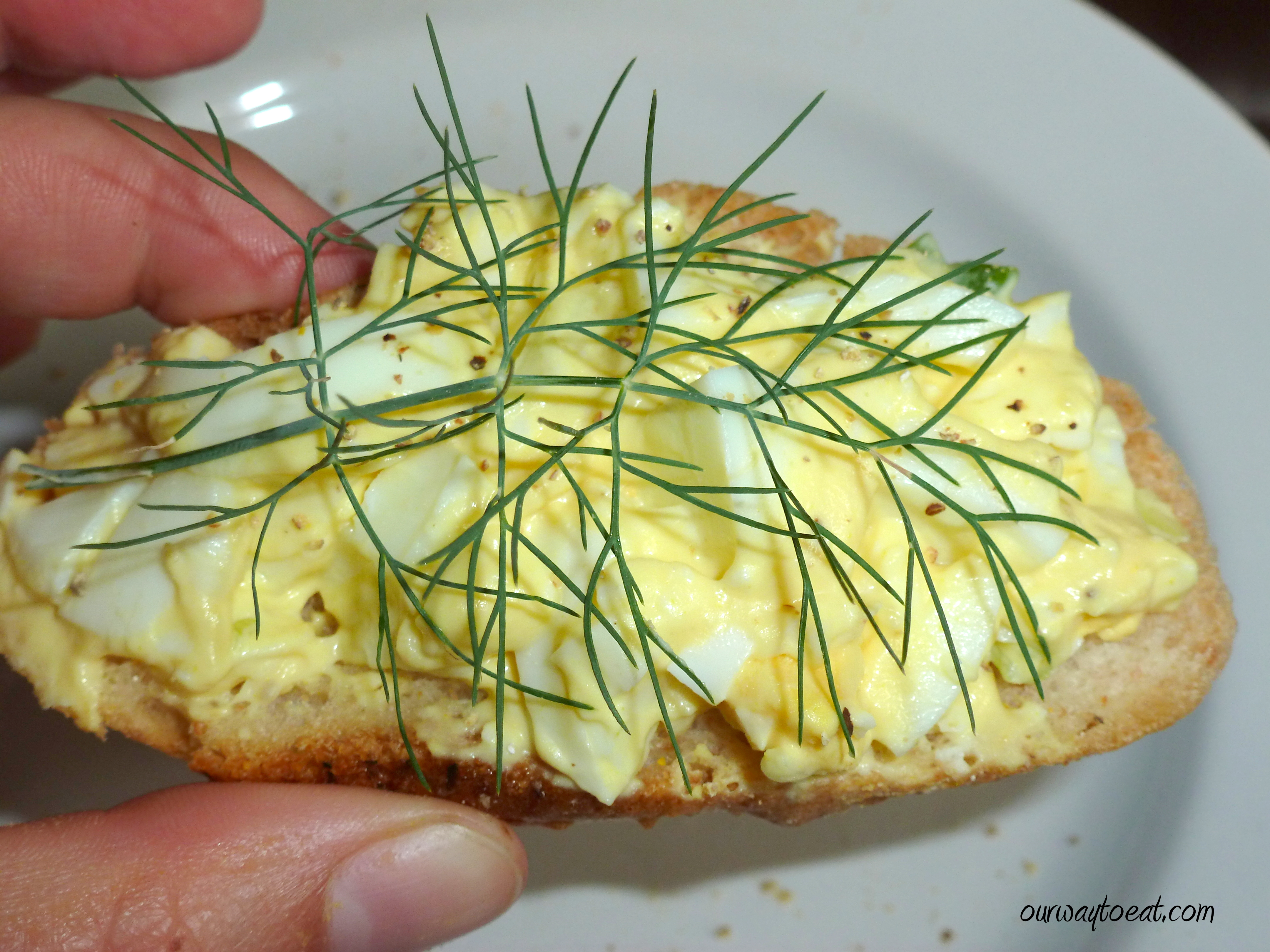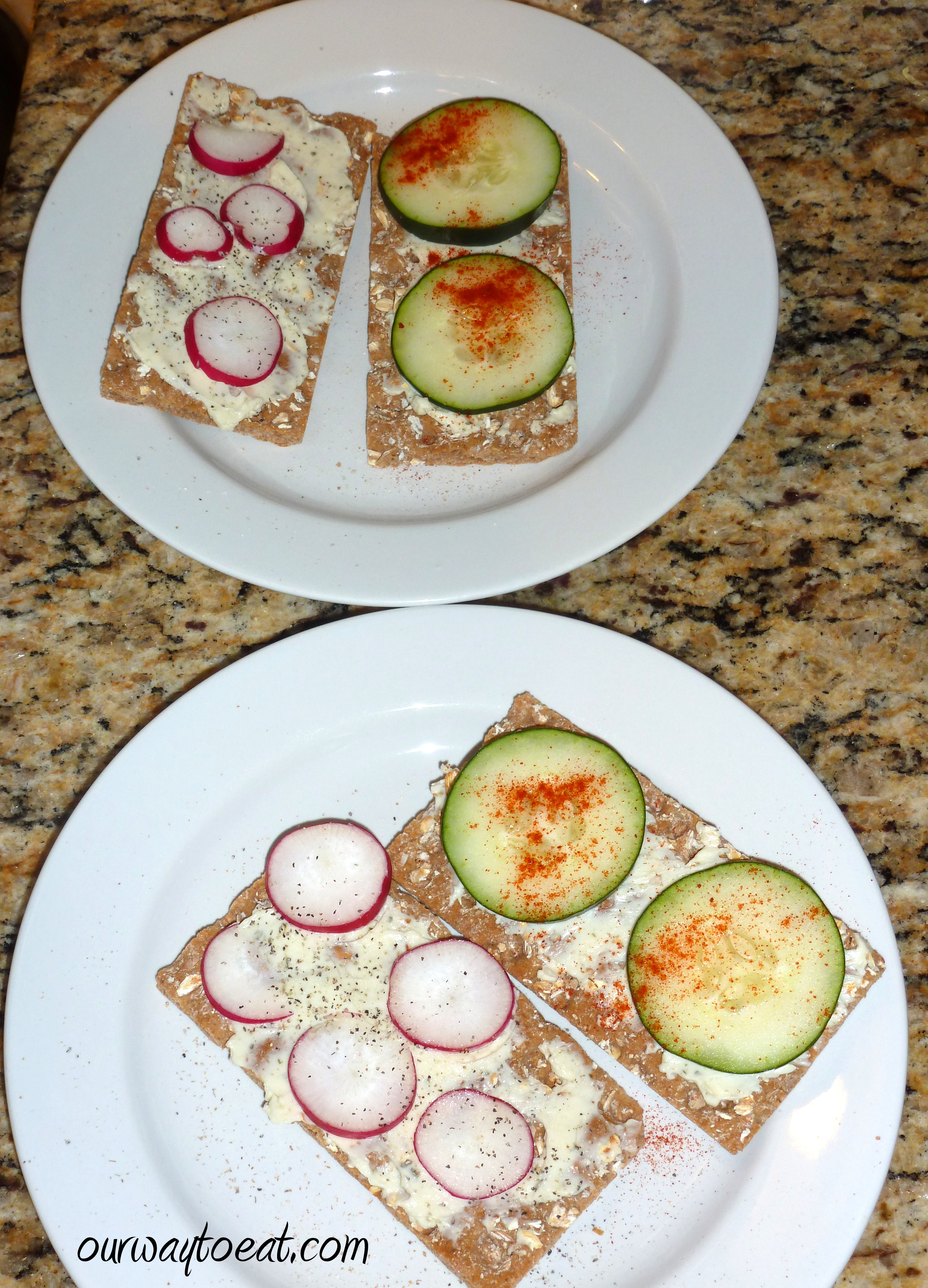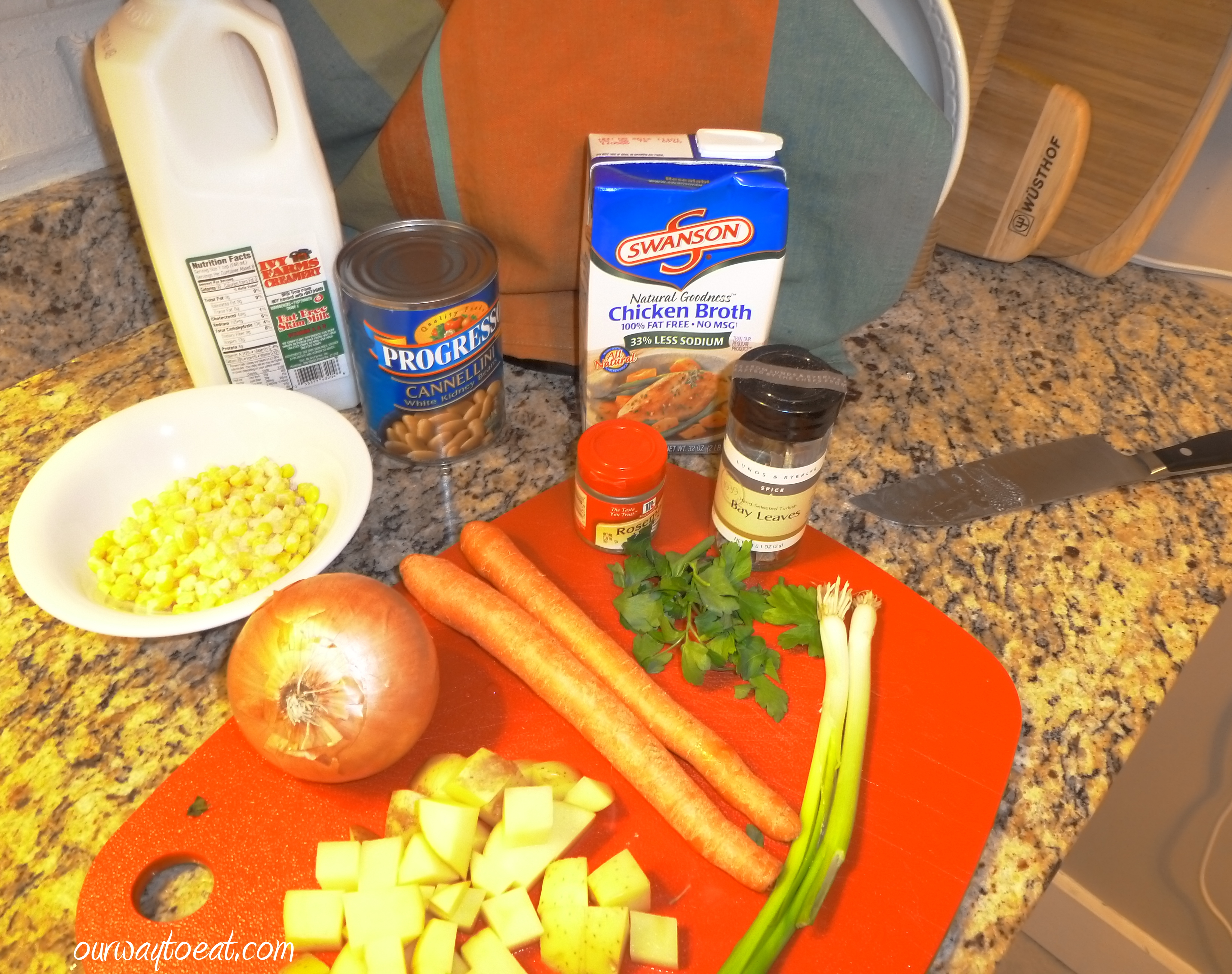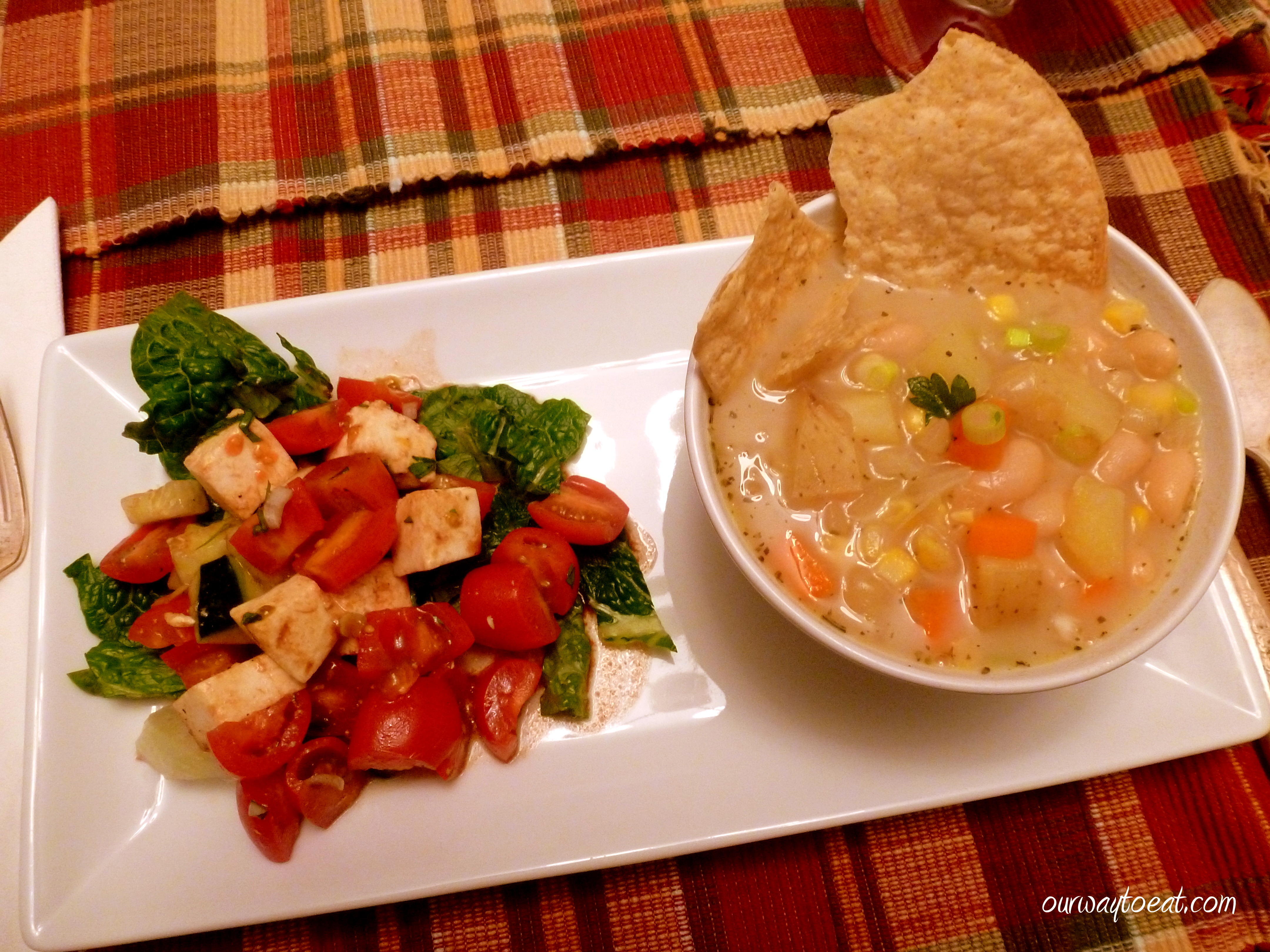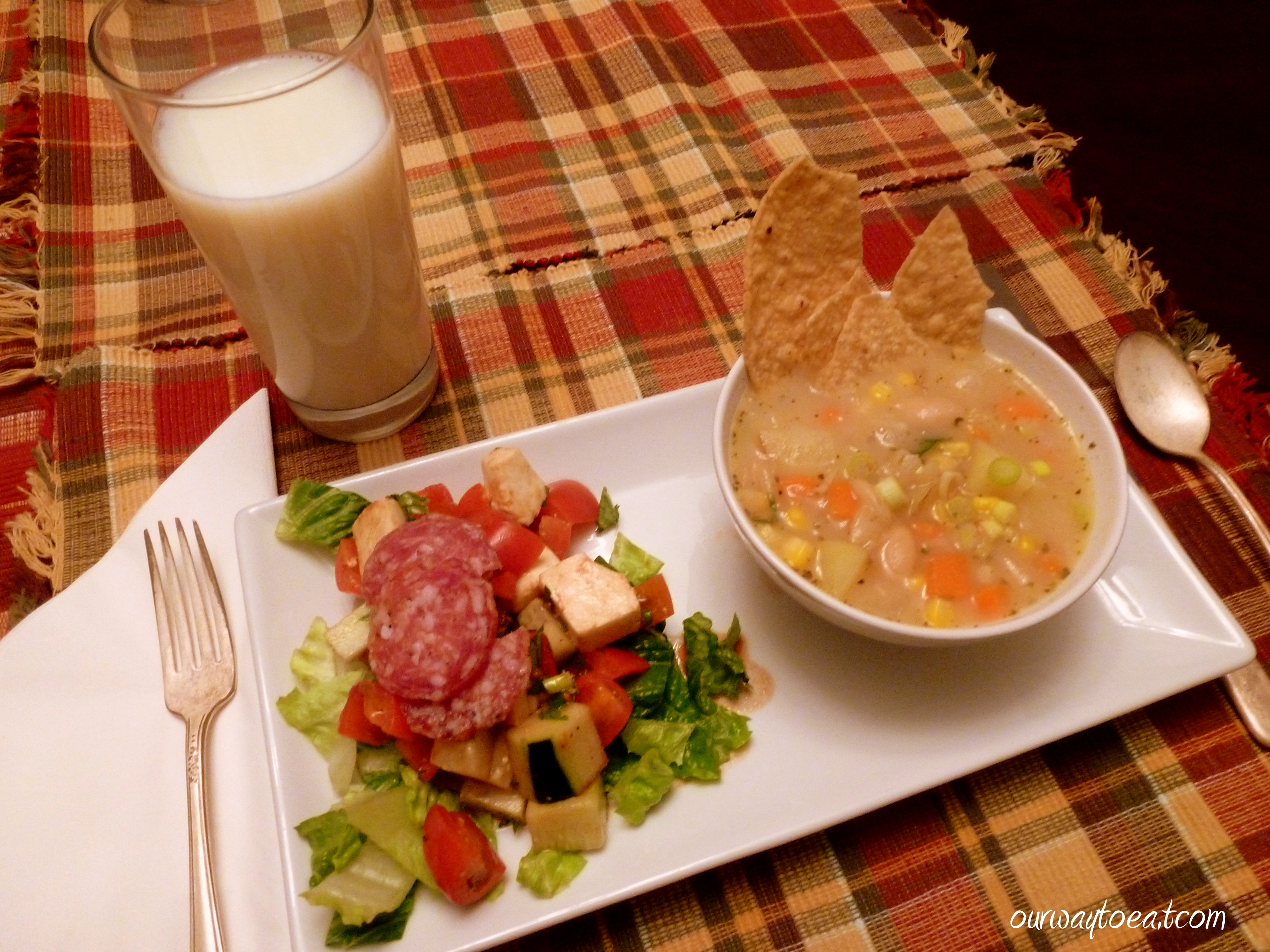I have been eating and making stir fries all of my life. Stir-frying vegetables and a protein of choice served with rice or noodles is a weeknight staple in so many homes. It is easy and flexible in that you can use whatever vegetables you have. It is also satisfying and can be quite healthy if you aren’t heavy-handed with oil in the preparation. I consider myself to be fairly adept at stir-frying vegetables to tender-crisp, but my challenge has been developing a tasty and full flavored sauce. I don’t buy stir-fry sauces, and in experimenting with the ingredients and seasonings used to develop flavor, I have served some meals in which the flavor was weak. After many trials and much error I took some guidance from others [here and here]. Now, I am finally cracking the code of making tasty stir-fry sauces from scratch that are simple and flavorful. Tonight’s Stir-fried Vegetables and Tofu with Udon Noodles in a Spicy Peanut sauce was declared a winner.
Stir Fried Vegetables with Tofu –Yields about 4 Hearty Servings
- 1 block of Extra Firm Tofu, with excess water removed then cut into cubes. Meat eaters might enjoy chicken, beef or pork instead of tofu, either pre-cooked, or sautéed with onions and other seasonings before vegetables are stir-fried.
- 1/3 of a Package of Udon Noodles – cooked according to package directions
- Olive Oil or Peanut Oil, for cooking
- Approximately 4 Cups of Vegetables, I used:
- ½ of a medium red onion, diced
- 1 broccoli crown, cut into florets
- 1 cup of fresh spinach
- ¾ cup of frozen soy beans (Edamame)
- ¾ cup of sliced button mushrooms,
- ¼ of a Red Bell Pepper, sliced into strips
- ¼ of an Orange Bell Pepper, sliced into strips
There are no limits on the vegetables that would be great in this Stir Fry. Other vegetables that come to mind include cauliflower, shitake or cremini mushrooms, green peas, green onions, water chestnuts, baby corn, bamboo shoots, carrots, celery, bok choy, cabbage, asparagus, snow peas, broccolini and green beans… It will be great with just about any vegetable you like. You simply assemble an assortment of vegetables, wash them, and then chop them into nice, bite-size pieces.

This is a meal that comes together quickly once you start cooking it, so I like to get all of the vegetables ready and make the sauce before I even start stir-frying the vegetables. I whisked together the following ingredients into a spicy-peanutty sauce. You can adjust the heat up or down according to your preference by adding additional Red Chili Flakes or Garlic-Chili paste. My sauce was fairly spicy to begin with, so I decided simply to stick to my original recipe. I placed a bottle of Rooster Sauce on the table in case either of us found the spice level to be lacking.
Spicy Peanut Sauce
- 2 tablespoons natural chunky peanut butter
- 1/3 cup veggie broth or water
- 1 1/2 teaspoons crushed red chile flakes
- 1 tablespoon honey
- 1 teaspoon ginger, minced
- 1 clove garlic, minced
- 2 tablespoons Braggs Liquid Aminos or soy sauce
- A squeeze of lime juice
Once the Spicy Peanut Sauce was ready and all of the veggies were chopped, I selected Japanese udon noodles from the pantry to serve with the stir-fried vegetables. I like udon noodles quite a bit. Even though udon have a light colour, they are a whole wheat noodle. They have a smooth texture and a similar size to linguine. Instead of udon noodles we often have nutty buckwheat soba noodles, rice noodles, regular whole grain spaghetti or occasionally rice. I have noticed that udon noodles are salty enough without additional salt added to the water as you would add to most pastas.
I like the way udon noodles come wrapped in individual portions. I typically make way too much pasta, and we have leftovers for days. The guidance helps.
Let me let you in on a nifty trick for preparing tofu to be cooked. When you purchase tofu packaged in water, you need to squeeze out some of the liquid so that the tofu can absorb the sauce and flavor of the vegetables. Rather than pressing tofu between plates and setting it precariously under a heavy object, which always wants to tip off and fall on my foot, someone once told me to wrap the tofu in a paper towel or a clean kitchen towel and microwave it for 2 minutes.* This process works wonderfully to remove the excess liquid from the tofu and makes it ready to absorb a flavorful sauce after being nuked on high for two minutes for 2 or three rounds. This is far easier and less dangerous for my feet. After microwaving the tofu and slicing it into bite sized cubes I started my veggies.
 Other than a great sauce, the key to a good stir-fry is not to overcook the vegetables. I always start with onion, giving it a 2-3 minute head start in the pan with a small glug of oil before adding anything else. I use a large, deep nonstick pan, because I don’t have a wok. A wok or a well-seasoned cast-iron pan are very helpful to making a healthy stir-fry because the vegetables don’t stick, even if you only use a little oil. Next, I add the remaining vegetables in the order that allows everything to finish cooking at the same time without overcooking any single ingredient. If I was using carrots and celery, for example, I’d add them first, and cauliflower soon after, followed by frozen vegetables, and finishing with mushrooms, bell peppers and anything that takes only a few minutes to cook. You can probably look up estimated cooking times for vegetables in a cookbook or on the internet. I have learned through trial and error. Tonight, I was able to add most of the vegetables at the same time, reserving the broccoli, tofu and spinach to add later, since they need a shorter cooking time.
Other than a great sauce, the key to a good stir-fry is not to overcook the vegetables. I always start with onion, giving it a 2-3 minute head start in the pan with a small glug of oil before adding anything else. I use a large, deep nonstick pan, because I don’t have a wok. A wok or a well-seasoned cast-iron pan are very helpful to making a healthy stir-fry because the vegetables don’t stick, even if you only use a little oil. Next, I add the remaining vegetables in the order that allows everything to finish cooking at the same time without overcooking any single ingredient. If I was using carrots and celery, for example, I’d add them first, and cauliflower soon after, followed by frozen vegetables, and finishing with mushrooms, bell peppers and anything that takes only a few minutes to cook. You can probably look up estimated cooking times for vegetables in a cookbook or on the internet. I have learned through trial and error. Tonight, I was able to add most of the vegetables at the same time, reserving the broccoli, tofu and spinach to add later, since they need a shorter cooking time.
When the veggies had cooked about 2 minutes and were looking bright and well on their way to tender-crisp, I added the peanut sauce, turned the heat to low and let the whole thing cook for 4 minutes. A few minutes with heat allows the salty-spicy-sweet-citrusy-nutty elements of the sauce to meld. 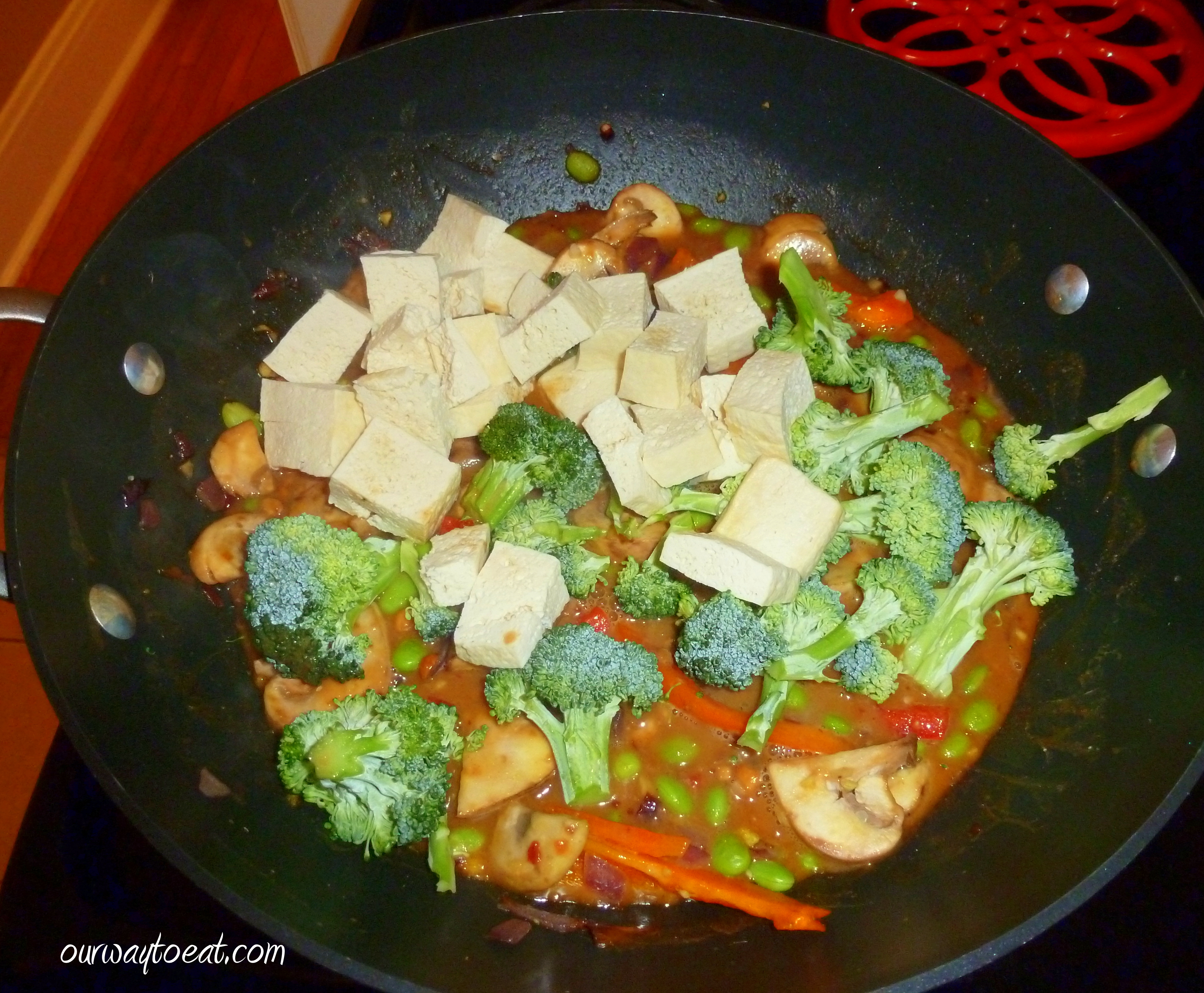 When I figured the vegetables and sauce needed another 4 minutes more to cook, I added the broccoli and tofu. Even though broccoli is a dense, cruciferous vegetable, it cooks quickly, and after no more than about 4 minutes, it is done. When the vegetables are done they are bright and softened, and still retain a firm bite. Tofu is great sautéed or broiled, but tonight I wanted to eat it fresh, so I cooked it just enough time to absorb the sauce and to be heated through.
When I figured the vegetables and sauce needed another 4 minutes more to cook, I added the broccoli and tofu. Even though broccoli is a dense, cruciferous vegetable, it cooks quickly, and after no more than about 4 minutes, it is done. When the vegetables are done they are bright and softened, and still retain a firm bite. Tofu is great sautéed or broiled, but tonight I wanted to eat it fresh, so I cooked it just enough time to absorb the sauce and to be heated through.
When the noodles were cooked, I drained them and served them on a small platter with a few sprigs of curly parsley. Cilantro would be a suitable garnish for the pasta, if you like cilantro, but we aren’t big fans. Before serving the stir-fry, I scattered the fresh spinach leaves in a pile on the platter. I could have stirred the spinach into the veggies and sauce and allowed it to wilt, but I find that spinach is great, even if it only half-wilts under a mound of steamy vegetables.

We both enjoyed this stir-fry. It was full of spicy, peanutty flavor and a bright variety of vegetables that retained their bite. The tofu also soaked up plenty of flavor and was as easy as could be to prepare. And the pasta? Everything tastes good on a serving of steamy, al dente pasta. When you are in the mood for an easy and delicious vegetable stir-fry, consider trying this tasty recipe. The sauce and veggies are full of texture and flavor. This dish is flexible, quick and easy enough to make any night of the week.
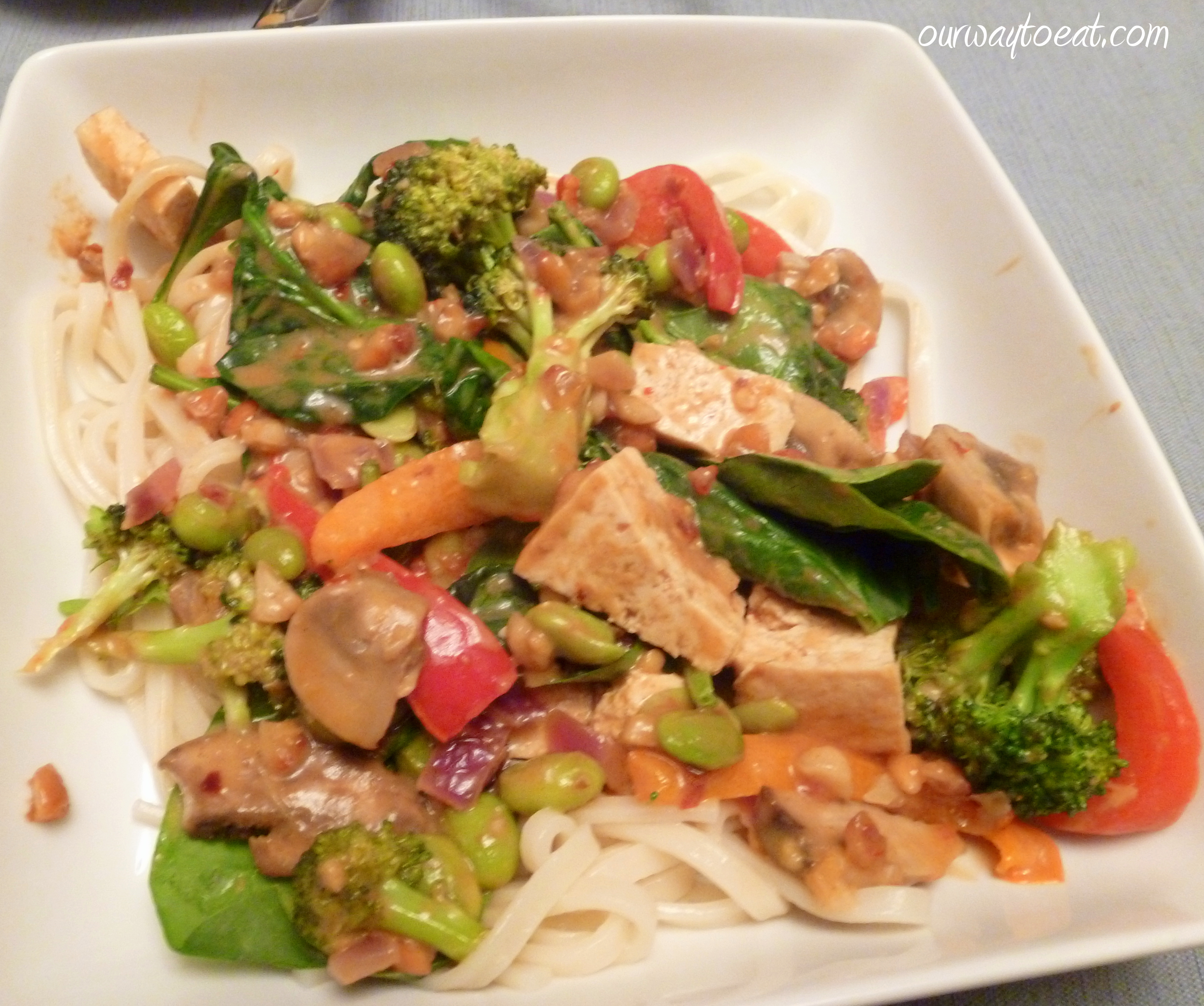
*Thank you to the person who told me the tofu-nuking tip, whoever you are. I am so pleased that I don’t have to press tofu ever again.




